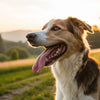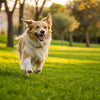How Long Should a Dog Wait to Eat After Exercise? Understanding the Optimal Feeding Schedule
- Houndsy
Table of Contents
- Introduction
- The Connection Between Exercise and Digestion
- How Long Should Dogs Wait to Eat After Exercise?
- Establishing a Feeding Schedule for Your Dog
- Nutritional Considerations for Post-Exercise Feeding
- Signs of Digestive Distress to Watch For
- Conclusion
- FAQ
Introduction
As dog owners, we often prioritize our furry friends’ exercise and nutrition, but did you know that the timing of meals in relation to exercise is crucial for their health? A staggering statistic reveals that up to 20% of dogs may experience bloat, a potentially fatal condition, due to improper meal timing around physical activity. This alarming figure highlights the importance of understanding how exercise impacts a dog's digestive system and how we can optimize their feeding schedule for better health.
In this blog post, we will explore how long dogs should wait to eat after exercise, the implications of feeding times on their digestive health, and best practices for establishing a feeding routine that supports your dog's overall well-being. By the end, you will have a clear understanding of how to help your dog recover properly after exercise, reducing the risk of digestive issues while ensuring they thrive.
We will delve into the nuances of canine digestion, the effects of exercise on their bodies, and practical tips for creating a feeding schedule that works for you and your pup. So, let’s embark on this journey to improve our dogs' feeding routines together!
The Connection Between Exercise and Digestion
Understanding Canine Digestion
Dogs have a unique digestive system that is designed to process their food efficiently. However, various factors, including the type of food they eat, their age, breed, and activity level, can influence digestion times. Generally speaking, it takes most dogs between four to eight hours to digest a meal completely. Larger and more active breeds may require even longer, while smaller breeds can often digest food more quickly.
When a dog exercises, blood flow is redirected from the digestive tract to the muscles, heart, and lungs, which can slow down the digestive process. This means that if your dog eats too soon before or after exercise, they may face complications such as an upset stomach, vomiting, or even more severe conditions like bloat (Gastric Dilatation-Volvulus or GDV).
How Exercise Impacts Digestion
When engaging in physical activity, dogs burn energy and create metabolic demands that can interfere with their digestive processes. Here are some key points to understand about this relationship:
- Reduced Blood Flow to the Digestive System: During exercise, blood is diverted to the muscles, which can slow digestion and lead to discomfort if food is present in the stomach.
- Risk of Bloat: Bloat is a life-threatening condition characterized by an accumulation of gas in the stomach. It is particularly concerning in deep-chested breeds. Feeding immediately after exercise increases the risk, as movement can cause the stomach to twist.
- Dehydration: Exercise can lead to dehydration, which affects digestion. A dehydrated dog may struggle to process food effectively, leading to further digestive disturbances.
- Recovery Time: Allowing your dog some downtime after exercise before eating enables their body to return to a calm state, facilitating better digestion and nutrient absorption.
How Long Should Dogs Wait to Eat After Exercise?
Recommended Waiting Periods
Experts suggest a general waiting period of 30 minutes to 2 hours after exercise before feeding your dog. The exact timing can vary based on the type and intensity of the exercise performed. Here’s a breakdown of suggested waiting periods:
- Light Exercise (e.g., leisurely walks): Wait at least 30 minutes before feeding.
- Moderate Exercise (e.g., play sessions or moderate jogging): Wait about 1 hour.
- Intense Exercise (e.g., running, agility training, or fieldwork): It is best to wait 1.5 to 2 hours before feeding.
By adhering to these guidelines, we can help our dogs avoid digestive discomfort and support their overall health.
Factors Influencing Feeding Timing
- Type of Exercise: As mentioned, the intensity and type of exercise your dog engages in will directly impact how long they should wait to eat. More vigorous activities necessitate longer recovery periods.
- Dog’s Age and Health: Puppies typically require more frequent meals and may tolerate shorter waiting periods, while older dogs may need additional time due to slower metabolism.
- Breed Considerations: Larger and deep-chested breeds require extra caution regarding meal timing and exercise to reduce the risk of bloat.
- Individual Differences: Every dog is unique, and their digestive capabilities may vary. Monitoring your dog's behavior after eating and adjusting meal times can help create a personalized feeding schedule.
Establishing a Feeding Schedule for Your Dog
Creating a Routine
Establishing a consistent feeding schedule can greatly benefit your dog's digestion and overall health. Here’s how to create a routine that works for both you and your pup:
- Set Regular Feeding Times: Aim to feed your dog at the same times each day. This consistency helps regulate their digestive system and can reduce anxiety around meal times.
- Plan Exercise Around Meal Times: If you know your dog is due for a meal soon, plan their walks or exercise accordingly. For instance, opt for a walk before feeding, or ensure ample time after feeding before engaging in physical activity.
- Monitor Portions: Adjust the amount of food you provide based on your dog’s activity level. For days with more exercise, consider increasing their food slightly, while reducing portions on less active days.
- Hydration is Key: Always ensure your dog has access to fresh water, especially before and after exercise. Proper hydration supports digestion and overall health.
Feeding Frequency
For most adult dogs, feeding them twice a day is ideal. Puppies, on the other hand, may require more frequent meals (3-4 times a day) to support their growth and energy needs.
Smaller, more frequent meals can help prevent bloat and ensure that your dog is receiving adequate nutrition throughout the day. If your dog is particularly active or has special dietary needs, consult your veterinarian for tailored advice.
Nutritional Considerations for Post-Exercise Feeding
What to Feed Your Dog After Exercise
After exercise, it's crucial to provide your dog with the right nutrients to aid recovery. Here’s what to consider:
- High-Quality Proteins: Lean meats (e.g., chicken, fish) and animal-based proteins are excellent choices for recovery, helping to repair muscle tissues and replenish energy stores.
- Complex Carbohydrates: Foods like brown rice, oats, or sweet potatoes provide essential energy for active dogs.
- Healthy Fats: Incorporating healthy fats (like fish oil) can support overall health and promote a shiny coat.
- Fruits and Vegetables: Adding fruits and vegetables (like carrots, apples, or green beans) can enhance your dog’s diet with vitamins, minerals, and antioxidants.
- Specialized Dog Foods: For active dogs, consider high-performance dog food that caters to their nutritional needs. Ensure it’s formulated for their specific energy levels and activity requirements.
- Avoid Heavy Meals: After intense activity, avoid feeding your dog a heavy meal immediately. Instead, consider smaller, easily digestible meals to gradually replenish their energy.
Signs of Digestive Distress to Watch For
As responsible pet owners, we must be vigilant about our dogs' health. Here are some signs to look out for following meals or exercise that may indicate digestive issues:
- Vomiting: Frequent vomiting after eating can signal an upset stomach or potential bloat.
- Lethargy: If your dog seems unusually tired or sluggish after a meal, it may indicate digestive discomfort.
- Distended Abdomen: A swollen or hard belly can be a sign of bloat and requires immediate veterinary attention.
- Restlessness: Dogs that are unable to settle down after eating or exercising may be experiencing discomfort.
If you notice any of these symptoms, it's essential to consult your veterinarian promptly.
Conclusion
Understanding how long your dog should wait to eat after exercise is vital for their health and well-being. By allowing adequate time between physical activity and meals, we can minimize the risk of digestive issues and ensure our dogs recover properly from their workouts.
Establishing a consistent feeding schedule, providing balanced nutrition, and monitoring for signs of distress will help our furry companions lead healthier, happier lives. Remember that every dog is unique, so be mindful of their individual needs and adjust their routines accordingly.
As we continue to elevate our dogs' daily experiences, consider enhancing their feeding ritual with the Houndsy Kibble Dispenser. Its innovative design ensures perfect portion control while complementing your home décor. By simplifying the feeding process, we can focus more on what truly matters—quality time spent with our beloved pets.
Explore the Houndsy Kibble Dispenser here and provide your dog with the ideal feeding experience!
FAQ
Q: How long should I wait to feed my dog after a walk?
A: It’s recommended to wait at least 30 minutes after a light walk and 1 to 2 hours after more intense exercise before feeding your dog.
Q: What are the risks of feeding my dog immediately after exercise?
A: Feeding immediately after exercise can lead to digestive issues, including upset stomach, vomiting, and potentially dangerous conditions like bloat.
Q: Are there different recommendations for puppies?
A: Yes, puppies may require shorter waiting periods and more frequent meals. Monitor their behavior and adjust feeding times accordingly.
Q: How can I tell if my dog is experiencing bloat?
A: Signs of bloat include a distended abdomen, restlessness, attempts to vomit, rapid breathing, and pale gums. If you notice these symptoms, seek veterinary care immediately.
Q: What should I include in my dog’s diet after exercise?
A: High-quality proteins, complex carbohydrates, healthy fats, and a variety of fruits and vegetables are excellent post-exercise food options for your dog.
By following these guidelines, we can help our dogs thrive and enjoy a healthy, active lifestyle!












